By London Underground
The familiar old 'Met Line' 'A' stock has been replaced by the new Bombardier 'S' stock, described in a Wikipedia article here. When deliveries are complete, 191 trains will have been supplied for the Metropolitan, Circle, Hammersmith & City and District Lines, provided with air conditioning and capable of running from 750 volts d.c. when the power supply is upgraded. The introduction of this fleet has not been without a fair amount of grief. The picture below is actually the first 'S' stock train I saw, back in April 2011.

Bombardier 'S' stock.
Perhaps even now all the problems have not been eliminated: my 'S' stock train started away from Euston Square and, after a few yards, made a sudden stop. After a short pause, we set off again and there were no further oddities, although I did find the Mitsubishi air conditioning noisy.
Liverpool Street Station
On arrival at Liverpool Street, I made my way via the escalators to the concourse of the main-line station. This is light and airy beneath a complex glazed roof supported on cast iron columns. The mezzanine floor with its range of retail units in a curious modern style was less appealing.
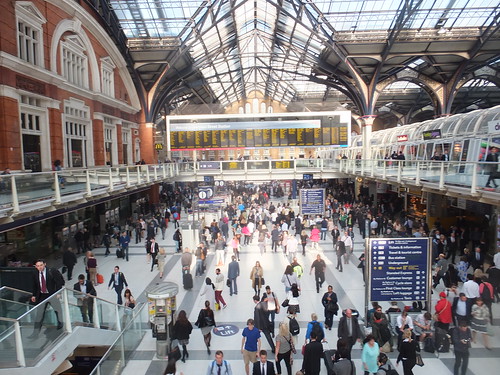 The concourse at Liverpool Street station.
The concourse at Liverpool Street station.
There have been so many rebuildings of the station that the present result is something of a pastiche, with many of the original features moved or modified. For example, the large War Memorial for World War I has been relocated and the lower left panel now features a set of lift doors.
 WWI War Memorial, complete with lift doors.
WWI War Memorial, complete with lift doors.
Liverpool Street Background
The station was first opened in 1874 to replace the earlier Bishopgate station (which became a goods depot). In 1890, work started to add a further 8 platforms on the eastern side of the station. The station suffered serious bomb damage during World War I but by the 1920s, an intensive suburban steam service (commonly called 'The Jazz') was carrying unprecedented numbers of commuters. In the 1930s, the electrification of the line to Shenfield was planned but implementation was delayed by World War II (when the station suffered bomb damage again). In 1949 the Shenfield line was electrified and, by 1960, the line to Chingford had also been electrified. The Broadgate Development, authorised in 1985, brought further major change. Broad Street Station (immediately to the west of Liverpool Street Station) was abolished and the area used for the development of commercial property. New connections allowed trains which had previously served Broad Street Station to be diverted to Liverpool Street Station. Further commercial building was authorised on the east side of Liverpool Street Station. A reconstruction of the station took place and, as part of the resignalling, Liverpool Street received the first Integrated Electronic Control Centre (IECC) in Britain. Queen Elizabeth II officially opened the redeveloped station in 1991. In 1993, the notorious Bishopgate Bombing caused further damage to the station. For more information on Liverpool Street, see the Wikipedia article here.
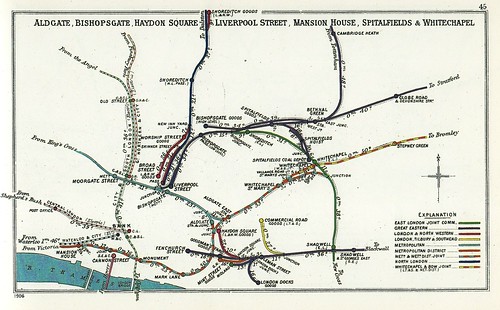 Click here for larger image
Click here for larger imageLines around Liverpool Street in 1906.
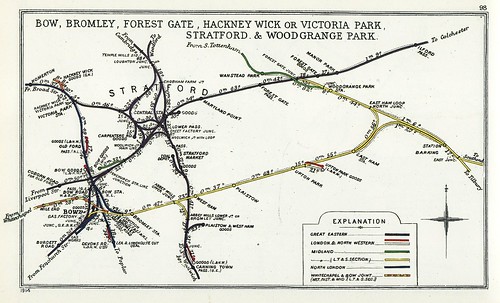 Click here for larger image
Click here for larger imageLines around Stratford in 1914.
Keith Jaggers has an interesting 1993 article about Liverpool Street here.
Travelling from Liverpool Street
In 2011 I'd travelled from Liverpool Street to Chelmsford for 'Lionsmeet 2011', described here.
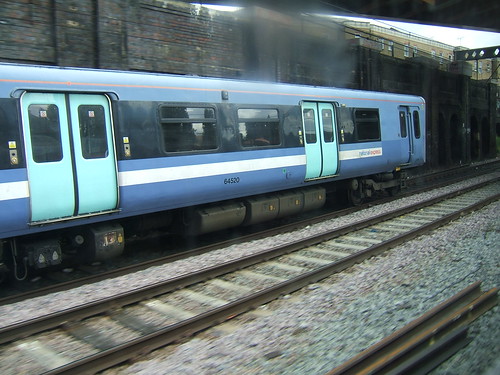 A 'national express' Class 313 service leaving Liverpool Street on the Down Suburban in 2011.
A 'national express' Class 313 service leaving Liverpool Street on the Down Suburban in 2011.
This time, I'd decided to travel as far as Stratford, so I made my way to a Southend service, a 12-car Class 321 in 'abellio greater anglia' livery. It appears that all these Train Operating Companies have a phobia concerning capital letters.
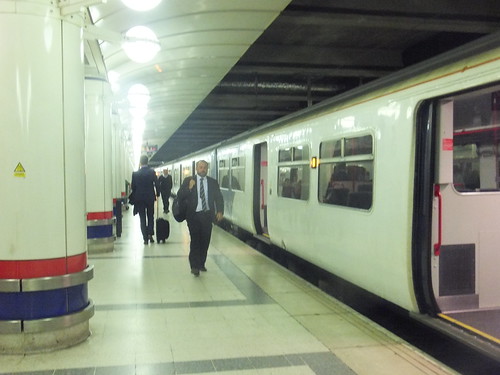 The Class 321 for Southend stands in Liverpool Street.
The Class 321 for Southend stands in Liverpool Street.
Leaving Liverpool Street, there are six running roads. From the west, the Down Suburban and Up Suburban pass through Bishopgate Tunnel, the Down Main and Up Main pass through a cutting, as do the Down Electric and Up Electric (despite the name, all six lines now have overhead electrification). Then we made the 1 in 70 climb to Bethnal Green, just over a mile from the start, where only the Suburban Lines have platforms before they sweep away to the left towards Hackney Downs, accompanied by two lines branched from the Main lines. Another mile and a half takes us to Bow Junction where a single line connection from the Fenchurch Street Lines joins on our right, together with the single line Docklands Light Railway from Poplar. On our left, the Down and Up Temple Mills diverge from the Main and run parallel while beyond lies the Olympic Park.
 The Olympic Park under construction in 2011. L: Olympic Stadium R: ArcelorMittal Tower.
The Olympic Park under construction in 2011. L: Olympic Stadium R: ArcelorMittal Tower.
The budget for the Olympic Stadium in the original bid was 300 million pounds. It actually cost 429 million pounds. It's currently being converted as a new home for West Ham Football Club. This was supposed to cost 154 million pounds but, at the time of writing, there's a wrangle over problems with the roof estimated at 15 million pounds. The ArcelorMittal Orbit (as it's now called with its strange capitalisation within a word) was commissioned as a piece of "Public Art". Huh? The picture below shows the same location in 2014.
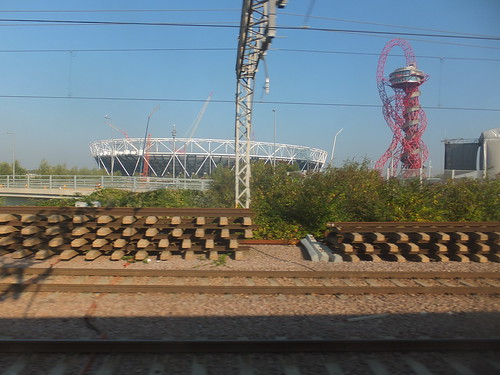 The same location in 2014. L: West Ham stadium under conversion R: ArcelorMittal Orbit.
The same location in 2014. L: West Ham stadium under conversion R: ArcelorMittal Orbit.
Just before Stratford station, Carpenters Road Curve and Channelsea Curve form a triangular junction on our left. I alighted at Stratford and took a few pictures around the station. To the south east, the Central Line trains still pop out of the ground, pause briefly, then dive underground again. A single bay platform terminates the Docklands Light Railway branch from Poplar. To the north west, the Down and Up Temple Mills diverge to the left and, beyond, a fairly modern island platform terminates the Overground services. Beyond that, the Westfield Stratford City looms over everything. It's a big shopping centre with 336 'stores'. Whatever happened to 'shops'?
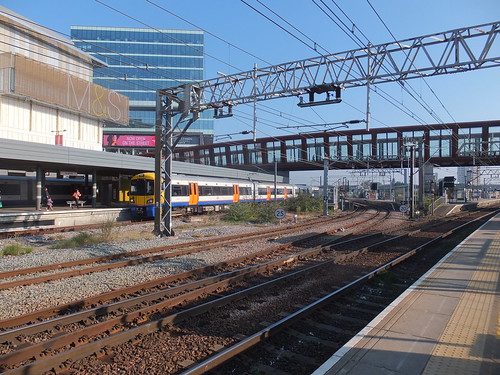 View of Stratford Station from platform 9. L to R: Westfield Stratford City, Overground platforms, Down & Up Temple Mills platforms, Southend lines.
View of Stratford Station from platform 9. L to R: Westfield Stratford City, Overground platforms, Down & Up Temple Mills platforms, Southend lines.
I left the station and walked north along Montfichet Road, skirting the towering walls of the Westfield Stratford City to reach the bridge over the High Speed One extension into St. Pancras.
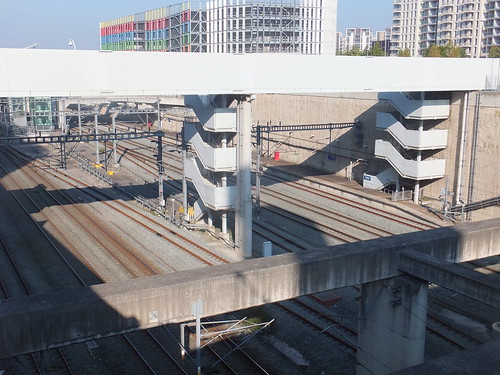 Trackwork at the east end of Stratford International.
Trackwork at the east end of Stratford International.
I returned to Stratford Station and decided that my best route to Victoria for my meeting would be Central Line to Oxford Circus and then Victoria Line two stops to Victoria. So that's what I did.
Books
[1] 'The Great Eastern Railway' by C. J. Allen published by Ian Allen (ISBN: 07110 0659 8).
[2] 'Great Eastern Album' by R. C. Riley published by Ian Allen (ISBN: 7110 0063 8).
[3] 'London's Termini' by A. A. Jackson published by Pan Books Ltd (ISBN: 0 330 02747 6).
Maps
'Railway Track Diagrams Book 2: Eastern' published by TRACKmaps (ISBN 0-9549866-2-8).
My pictures
London: Former Great Eastern Line.
Channel Tunnel and High Speed One.
London.
